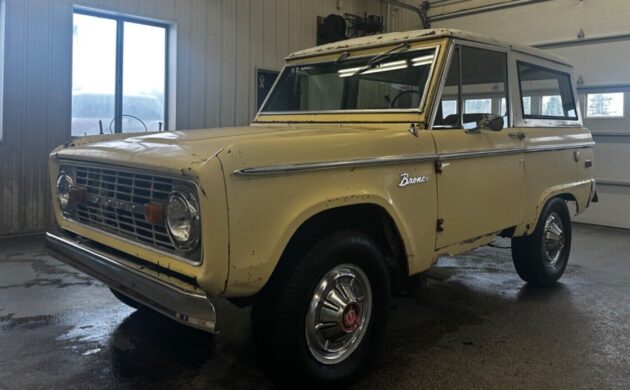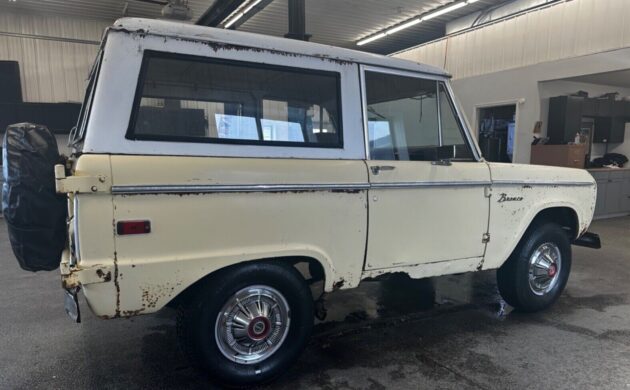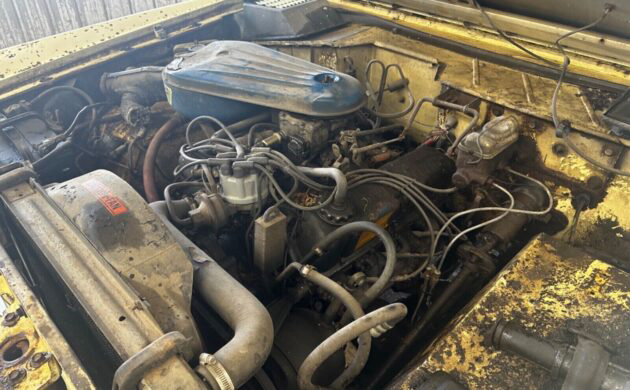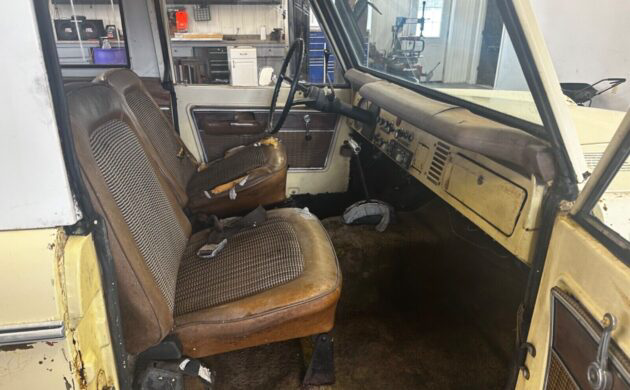Determining which vehicles will become desirable classics in fifty years is a “crystal ball” exercise. Some candidates, like the Corvette, Camaro, and Mustang, are obvious choices. However, if you had told a Bronco owner in 1973 that their new toy would command a healthy five-figure value in 2023, they probably would have locked you up and thrown away the key! However, the seemingly impossible has happened, and even rusty examples like our feature Bronco fall into that category. It is an unmolested vehicle that features a V8 under the hood. Its rust issues are significant, but that hasn’t stifled the bidding since the seller listed it here on eBay in Cambridge, Minnesota. The price has soared to $16,100 in a No Reserve auction.
So, where to start with this Bronco? Its original owner ordered it in Tampico Yellow, although the paint is faded and tired. However, rectifying that problem is small change compared to the rust repairs the winning bidder faces. The tin worm has sunk its teeth into the areas we have grown to know and love in First Generation Broncos. The rockers resemble Swiss cheese, the floors are rotten, and the pillars exhibit significant problems. It appears the inner front fender wells are succumbing, and there may be issues developing where the top meets the body. However, there are positive attributes worth considering. The frame appears to wear nothing but surface corrosion. The doors, front fenders, rear quarter panels, and hood look okay, and nobody has cut the wheel arches to accommodate large wheels. My only other qualm with this Bronco is the fit of the doors. Both look slightly odd, but the driver’s side seems particularly strange. Determining what is going on is challenging, but the last photo in this article shows it sitting at a weird angle with odd gaps. It may indicate the bodyshell is twisted, and rectifying a potential fault of that magnitude is a task that is typically beyond the average enthusiast. The Bronco retains its factory wheels and hubcaps, and the remaining trim looks restorable. There are no glass issues in a classic that raises as many questions as it answers.
This classic’s drivetrain is standard fare for a 1973 Bronco. The buyer receives a 302ci V8, a three-speed automatic transmission, a dual-range transfer case, and power steering. There has long been debate about the merits of buyers selecting the optional V8 over the Bronco’s entry-level 200ci six, and it is worth examining. The 200 delivers 84hp and 151 ft/lbs of torque, while the V8 lifts those figures to 137hp and 230 ft/lbs. Both produce their power and torque at about the same spot in the engine’s rev range, but the V8 (naturally) offers better acceleration and a more effortless open-road motoring experience. Therefore, the larger motor would seem a clear and decisive winner. However, the six provides a couple of advantages worth considering. The V8 brings a 200 lb weight penalty, with most of that additional mass hanging over the front axle. Without power steering, maneuvering in tight spaces is physically demanding. This is less of a problem with the 200ci powerplant. The smaller engine also uses 20% less fuel than its V8 sibling, which probably doesn’t seem like a big deal…until you’ve delved deep into the wilderness and realized the fuel gauge is falling perilously close to the “Empty” mark. Therefore, it is generally a “swings and roundabouts” situation where each engine has distinct advantages in certain circumstances. The seller states this Bronco runs and yard drives, but it isn’t genuinely roadworthy. The sound engineering employed by Ford when developing the Bronco means that achieving a mechanically roadworthy state is unlikely to be complicated or expensive, but I suspect that getting the body structurally sound will be the priority.
.This Bronco’s interior is complete, and the only visible change or aftermarket addition is the radio/cassette player occupying the spot reserved for the factory AM radio. The shifter is in its rightful place on the column, but everything needs an enormous dose of love to return to its former glory. Interior trim kits in the correct materials and colors are available, and that is one of the characteristics that make these classics satisfying project candidates. A complete kit to achieve a factory-fresh appearance will cost approximately $2,200. That seems like a reasonable investment, but it would be wise when we consider the Bronco’s potential value.
Although Bronco values have taken a hit over the past year, they continue to enjoy strong support in the classic market. If the new owner restored this 1973 example to a pristine factory state, a value of $70,000 should be within reach. It will cost a pretty penny to reach that point, and the specter of the potentially twisted bodyshell is hanging over its head. Sometimes investing in a classic project involves risk, but is it one you would take in this case? It will be interesting to gauge your thoughts.









Very rough..lots of coin and time to bring this one back….best to move on and keep looking for your Bronco….
I have some trim pieces for the Edsel you bought off us in Pilot Country. Call me 8135038254. Paul
I spent a couple weeks every summer on a large ranch back in the very early seventies that had a half dozen of these I thought they were pretty cool even back then.
I have to wonder if the twisted body shell is due to rust at the body mounts under the firewall and again at the rear. If this were not worth so much as it sits likely it would be a candidate to throw away the body and make some other car a 4×4.
By the time someone buys this Bronco and attempts to restore it back to factory they might be ahead going and getting a new one
This could be a parts bronco for a better bronco project find I think. Opening a can a worms if this is to be your project find.
Looks like if you took the top off it would fold up like a taco. Bids are way to high for a taco.
yup, 3 or 4 like this made mine in the ’80s.
My brother had one in the 80’s as well. Bought a fiberglass body with one piece flip up front end. Potent 302/auto combo. Project was going along nicely until he got laid off. Had to sell unfinished. Wonder whatever happened to it.
It will get s Coyote, some new paint and a suspension upgrade and be listed for $200k in about a month.
Let’s see how much a VIN tag is worth.
OK FOLKS, I have reached my threshold of pain with Ford Broncos. They are not a limited production car. They were produced and sold by the tens of thousands. The build of the Bronco was with minimalist materials, from the interiors to the sheet metal bodies, which were a rust magnet from the moment you took delivery. Much like the Ford Falcon, towards the end of the run, Ford decided to discontinue production based on dwindling sales. Somebody please explain what is the attraction to the Ford Broncos when you can put down the same money on a new 21st Century Ford Bronco, that has a build quality far superior to one’s similar to this bucket of rusty nuts, bolts and sheet metal. By the time you get this bucket of rust back in shape, you could have bought a new one.
Yeah I’d spend that much net on a new Bronco.
My gawd….the oxidation of it all!